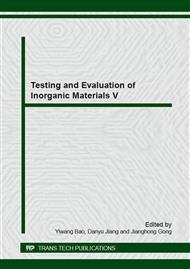p.49
p.53
p.57
p.61
p.65
p.69
p.73
p.77
p.82
The Effects of Mineral Composition and Sintering Temperature on Synthetic Mullite
Abstract:
Mullite material was prepared from quartz (SiO2) and industrial alumina (γ-Al2O3). The effects of mineral composition and sintering temperature on the final phase composition and physical properties of mullite were investigated. The results shown that a large number of mullite phase was emerged in samples when the ratio of alumina to silica (A/S) was 2.55. At 1500 oC and 1600 oC, the flexural strength of the samples reached to 87.13 MPa and 89.50 MPa, respectively. Consider the environmental protection and energy saving, the optimal sintering temperature was 1500 °C.
Info:
Periodical:
Pages:
65-68
Citation:
Online since:
November 2014
Price:
Сopyright:
© 2015 Trans Tech Publications Ltd. All Rights Reserved
Share:
Citation:


